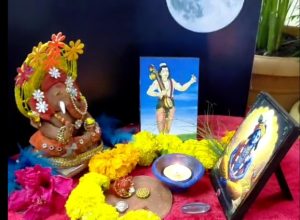Syamantaka Mani and Ganesha story

After attending the Ganpati Idol workshop thought of putting a theme to my work. Since Krishna Janmashtami and Ganesh Chaturthi generally occur within a few days of each other I thought of something involving both and come up nothing better than the story of Syamantaka Mani and Ganesha story.
Syamantaka Mani & Ganesha Story
On every Ganesh Chaturthi, it is tradition to listen to the Ganesh Chaturthi story. On one hand, it is an interesting story that children enjoy. On the other, it carries deep meaning and metaphors, guiding us on how to live our lives.
The story goes that Lord Ganesha had traveled to the homes of all his devotees, partaking in the feasts prepared for him. On his way back to Kailasa, he heard laughter. The Moon, radiant in the night sky, was mocking Ganesha, amused at the sight of him riding a tiny Mushika, the rat.
Offended, Ganesha cursed the Moon: “You will lose your luster, you will become dark.” This curse was symbolic—when ego takes over, the light of the Atma no longer shines, and the mind becomes dark. Ashamed, the Moon begged forgiveness. Ganesha, ever merciful, said: though you will lose your light and become dark, your sincere repentance will restore your radiance. This, it is believed, is why the Moon has its phases—the waning Krishna Paksha and the waxing Shukla Paksha.
Ganesha also declared: “Let this be a lesson. None should mock others. On my day, Ganesh Chaturthi, no one should look at you. Whoever sees the Moon then will be falsely accused of things they have not done.” People wondered if this curse truly took effect. The scriptures narrate the story of Lord Shri Krishna and the Syamantaka Mani to explain. The Sun God, Surya, gifted the Syamantaka Mani to Satrajit, a nobleman of the Yadava Empire, Krishna’s clan. The gem had a unique property—its possessor enjoyed prosperity, not just for himself but for his people. Satrajit’s dominion flourished with no famine or drought, and the gem produced eight measures of gold daily.
Krishna suggested that Satrajit give the Mani to the emperor so the entire kingdom could prosper. But Satrajit, possessive of the gem, refused. During Ganesh Chaturthi season, Satrajit’s brother Prasanjit wore the gem on a hunting trip and never returned. Days passed, and suspicion fell on Krishna. People spread the rumor that Krishna coveted the Mani and had seized it. Shocked, Krishna sought to clear his name. He ventured deep into the forest, where he found Prasanjit’s body, mauled by a lion. Following the tracks, Krishna found the dead lion, slain by a bear, and then tracked the bear into a cave.Inside, he saw a bear cub playing with the Syamantaka Mani. Its father soon appeared—none other than Jambavan, the great warrior from the Ramayana who had aided Rama against Ravana. Not recognizing Krishna as his Lord in another form, Jambavan challenged him.
A fierce battle ensued, lasting 28 days. At last, Jambavan realized: “You must be Lord Rama himself, for none but Rama could wrestle with me so long.” Krishna reminded him of the boon he had granted during the Ramayana war. Back then, Jambavan had asked Rama for a wrestling match. Rama, being the dignified Maryada Purushottama, had declined but promised it would be fulfilled when he came again as Krishna, the playful one.Recognizing his Lord, Jambavan bowed, returned the Syamantaka Mani, and offered his daughter Jambavati in marriage. Krishna accepted.
Returning to the kingdom with both Jambavati and the gem, Krishna gave the Syamantaka Mani back to Satrajit. Realizing his mistake in falsely accusing Krishna, Satrajit begged forgiveness and offered his daughter Satyabhama to Krishna in marriage. Krishna then reflected: why did all this unfold? He remembered that on Ganesh Chaturthi he had accidentally seen the Moon reflected faintly in milk. Even such a subtle glance invoked the curse, leading him to be falsely accused.
To free himself, Krishna molded a clay idol of Ganesha, performed worship and elaborate rituals, and was redeemed from the curse. Yet he realized that ordinary people would not be able to perform such penance. So he declared: “Whoever listens to the story of how I cleared my name by retrieving the Syamantaka Mani will be freed from the effects of this curse.” And so, just like we take vaccines for protection, listening to this story on Ganesh Chaturthi serves as a preventive remedy against false blame and accusations.
Om Gam Ganapataye Namaha.

Wasn’t aware of this beautiful story. Thanks for sharing and putting it up so well !
Thank you Komal
Thanks a lot for sharing this story.
Thank you Sanjay
I wasnt aware about the story related to the sighting of moon during Ganapati festival. Normally, during the festival the moon is hidden behind the monsoon clouds and is actually hardly ever visible. Thank you.
Thank you Manish
Thank you for sharing and explaining it so beautifully 🙏🏻
Thank you Sneha